King's Quest:
Quest for the Crown
Development history
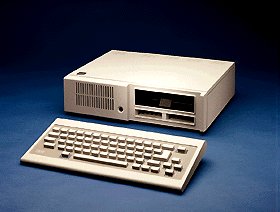 In
1983, Sierra On-Line was still a pretty small company, but it was
growing quickly. They had developed graphical adventure games, primarily
for the Apple II, and numerous arcade games for a lot of different
platforms. Many companies were competing to get a piece of the quickly
growing and very lucrative home computing business. There was a great number
of home computers made by a great number of companies available on the
market.
In
1983, Sierra On-Line was still a pretty small company, but it was
growing quickly. They had developed graphical adventure games, primarily
for the Apple II, and numerous arcade games for a lot of different
platforms. Many companies were competing to get a piece of the quickly
growing and very lucrative home computing business. There was a great number
of home computers made by a great number of companies available on the
market.
IBM had launched
the IBM PC in 1981. It was a business oriented microcomputer built
with standard parts, making it easy to clone. They had not really expected
it to be a big success. But it was, and it made them realize what a lucrative
market they had entered. The IBM PC quickly became the #1 platform in the
offices, but it was too expensive for the home market and didn't have the
hardware to compete with computers such as the Apple II or the Commodore
64 in the graphics and sound department.
Trying to
get their foot into the home computer market as well, IBM started designing
a home oriented version of the PC, called the PCjr. Available for
a much lower price than the regular PC and with 16-color graphic capabilities,
three-channel sound and 128k of memory it was thought to take the home
consumers by storm. Two cartridge ports would make it easy even for children
to load and play their favorite games and a new wireless keyboard with
rubber "chicklet" keys was thought to be a hit.
But impressive
hardware was not going to be enough. They needed some software to show
off the features of the IBM PCjr. They needed a computer game! Sierra On-Line,
famous for their revolutionary Apple II games, seemed like the right company
to create a cool game for the new computer, so they were contacted by the
people at IBM.
Ken and Roberta
was given a very interesting offer: IBM wanted a game for the PCjr. It
was going to be distributed and sold by IBM, but they would pay royalties
to Sierra On-Line, fund the entire development process and even feature
the game in their TV advertisements! But of course, the game IBM wanted
had to be not only good; they wanted something truly groundbreaking! Ken
and Roberta, eager to take on new challenges, were extremely excited by
the offer. They accepted it and immediately started to work on the project.
Roberta made
up a game concept similar to Wizard and the Princess. Her interest
in folklore and fairy-tales inspired her to create a classic story about
a knight that had to find and recover three stolen treasures and return
them to the king. She wanted the game to be just like an animated cartoon
that the player was in complete control of. The name "King's Quest”
was invented by either Ken or Roberta (they probably would disagree if
you asked them).
In Roberta's
design, your character in the game was going to be seen in a third-person
view. He would be fully integrated into a pseudo-3D environment where he
could walk freely, even behind or in front of objects. It would have fluent
animation in 16 colors and 3-channel sound and music effects playing in
the background. The text parser needed to be more "intelligent" than the
ones in the old Sierra On-Line adventures, understanding much more complex
commands. People were totally blown away when they saw Roberta's design
specs and didn't think it was possible to actually program it. But Roberta
was determined and didn't let go of her design.
The size and
complexity of the game required special software tools to handle all of
the text, graphics, sound and logic code of the game. For this, Sierra
On-Line created AGI (Short for Adventure Game Interpreter),
a system to bring all the data together and run the game.
The amount
of graphics Roberta wanted was a problem. The memory limitations of the
PCjr made it impossible to save everything as bitmaps. The solution was
a very interesting one: To use vector graphics for the background pictures!
Instead of bitmaps there was going to be a series of instructions to the
AGI interpreter for every picture, telling it to draw lines, filled surfaces
etc. to create the background graphics. (In the pre-1987 versions of the
game you could actually see the screens getting "drawn" every time you
entered a new screen because of this and the available CPU speeds at the
time.) This made it possible to represent the background pictures with
very little data. Animated details, such as the main character graphics,
could not be represented in that way but were small enough to be saved
as regular bitmaps. The PCjr had a 320x200 pixel resolution with 16 colors
available, but for memory reasons the lower resolution of 160x200 had to
be used instead. This resolution provided pixels nearly double as wide
as they were high, but it still made a very impressive view for the game.
The sound
hardware on the PCjr was much better than the one on the standard PC, but
it was still pretty simple and although it was utilized in the game, very
little music and sound effects could be heard in the game. It was not considered
to be that important.
The AGI system
stored all of the game data in "resource" packages. Text messages, graphics
and sound was all stored separately. The code that tied everything together
into a game was written in a specially designed script language, similar
to a regular high-level programming language but designed exclusively for
adventure game creation. The nice thing about this design was that King's
Quest and any other AGI-based game could easily be ported to other
systems. All you needed was a version of the interpreter written for the
new system that would run the game code. The games themselves didn't need
to be rewritten for the new system. Basically, all they needed to to was
to transfer the old game data to the new system and compile it.
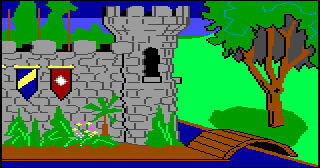
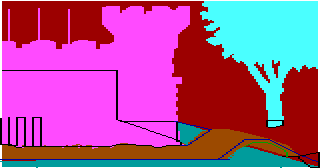 The
effect of walking behind or in front of objects on the screen and the possibility
to have special actions assigned to special areas of the screen seems pretty
advanced, but it's actually achieved in a very simple way: For each location
in the game, there's not one but actually two pictures stored. One
is the regular background picture that the player sees. The other picture
is invisible to the player and controls what happens when the character
walks around on that screen. Objects on the visible picture that should
be able to obstruct the character graphics have their corresponding pixels
in the invisible picture drawn in a solid color. Different colors give
different "priorities" to the object, thus making it possible to have one
object obstructing the character when he's at a specific location while
at the same time another object further back in the picture is not. Also,
a number of "control lines" are used in numerous ways. They can work as
boundaries that the character cannot cross or they can set certain variables
when crossed, making it easy to determine if the player is standing close
enough to something to perform an action on it or if he's walked into a
deadly spot.
The
effect of walking behind or in front of objects on the screen and the possibility
to have special actions assigned to special areas of the screen seems pretty
advanced, but it's actually achieved in a very simple way: For each location
in the game, there's not one but actually two pictures stored. One
is the regular background picture that the player sees. The other picture
is invisible to the player and controls what happens when the character
walks around on that screen. Objects on the visible picture that should
be able to obstruct the character graphics have their corresponding pixels
in the invisible picture drawn in a solid color. Different colors give
different "priorities" to the object, thus making it possible to have one
object obstructing the character when he's at a specific location while
at the same time another object further back in the picture is not. Also,
a number of "control lines" are used in numerous ways. They can work as
boundaries that the character cannot cross or they can set certain variables
when crossed, making it easy to determine if the player is standing close
enough to something to perform an action on it or if he's walked into a
deadly spot.
It took Roberta
and her small team of programmers eighteen months of work and a development
cost of about $700,000 to create King's Quest, the first three-dimensional
animated adventure game ever. The first version of the game was published
and distributed by IBM. It was the first game released on the PCjr. It
was packaged in a grey box with a cover picture of a knight in armor. (Quite
interesting actually, as you never really wear an armor in the game. A
part of the text on the front even says "Put on your armour - and your
thinking cap". Apparently, IBM made the box before the game was finished
and assumed that because the main character was a knight, he would wear
a suit of armor in the game.) It had a manual written by IBM and a "chicklet"
keyboard overlay with a scene from the game and markings of the commands
to use on it. This was a pretty interesting idea: Different game developers
could design different overlays for their games, showing the player what
keys to press when playing the game.
In 1985, when
IBM stopped production of the PCjr and the Tandy Corporation launched the
PCjr-compatible Tandy 1000, Sierra On-Line was fast to release King's Quest:
Quest for the Crown in a Tandy 1000 version. They also released an IBM
PC version with CGA graphics and single-voice PC Speaker sound. All of
the releases were booter versions with copy protection.
In 1987, the
game was re-released in a DOS version that supported both CGA and EGA graphics
on the PC, as well as supporting the PCjr and Tandy 1000. This time it
was packaged in a slipcover box on one 5.25'' and one 3.5'' disk. This
was the first time when the game was published with the Quest for the
Crown subtitle. The previous versions had just been called King's
Quest, but at the time of the re-release, the game already had two
sequels and a third was in development, so the subtitle was added to distinguish
the first game from the name King's Quest as a general description
of the whole series.
King's Quest:
Quest for the Crown was also released in a console version for the
Sega Master System in 1989, designed by Microsmiths Inc.
and published by Parker Brothers. It had totally different graphics
and rewritten text, but the gameplay was almost identical to the original.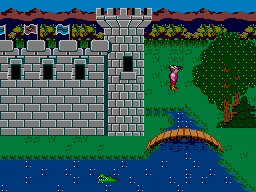
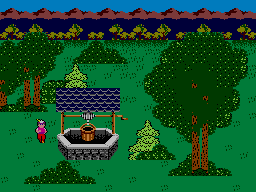
Back
to King's Quest: Quest for the Crown - Main page
Back
to The King's Quest games - Main page
Back
to The King's Quest Chronicles - Main page

 The
effect of walking behind or in front of objects on the screen and the possibility
to have special actions assigned to special areas of the screen seems pretty
advanced, but it's actually achieved in a very simple way: For each location
in the game, there's not one but actually two pictures stored. One
is the regular background picture that the player sees. The other picture
is invisible to the player and controls what happens when the character
walks around on that screen. Objects on the visible picture that should
be able to obstruct the character graphics have their corresponding pixels
in the invisible picture drawn in a solid color. Different colors give
different "priorities" to the object, thus making it possible to have one
object obstructing the character when he's at a specific location while
at the same time another object further back in the picture is not. Also,
a number of "control lines" are used in numerous ways. They can work as
boundaries that the character cannot cross or they can set certain variables
when crossed, making it easy to determine if the player is standing close
enough to something to perform an action on it or if he's walked into a
deadly spot.
The
effect of walking behind or in front of objects on the screen and the possibility
to have special actions assigned to special areas of the screen seems pretty
advanced, but it's actually achieved in a very simple way: For each location
in the game, there's not one but actually two pictures stored. One
is the regular background picture that the player sees. The other picture
is invisible to the player and controls what happens when the character
walks around on that screen. Objects on the visible picture that should
be able to obstruct the character graphics have their corresponding pixels
in the invisible picture drawn in a solid color. Different colors give
different "priorities" to the object, thus making it possible to have one
object obstructing the character when he's at a specific location while
at the same time another object further back in the picture is not. Also,
a number of "control lines" are used in numerous ways. They can work as
boundaries that the character cannot cross or they can set certain variables
when crossed, making it easy to determine if the player is standing close
enough to something to perform an action on it or if he's walked into a
deadly spot.
 In
1983, Sierra On-Line was still a pretty small company, but it was
growing quickly. They had developed graphical adventure games, primarily
for the Apple II, and numerous arcade games for a lot of different
platforms. Many companies were competing to get a piece of the quickly
growing and very lucrative home computing business. There was a great number
of home computers made by a great number of companies available on the
market.
In
1983, Sierra On-Line was still a pretty small company, but it was
growing quickly. They had developed graphical adventure games, primarily
for the Apple II, and numerous arcade games for a lot of different
platforms. Many companies were competing to get a piece of the quickly
growing and very lucrative home computing business. There was a great number
of home computers made by a great number of companies available on the
market.

